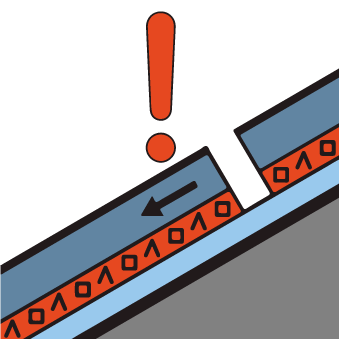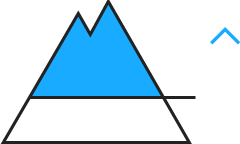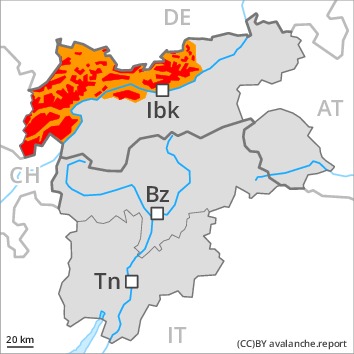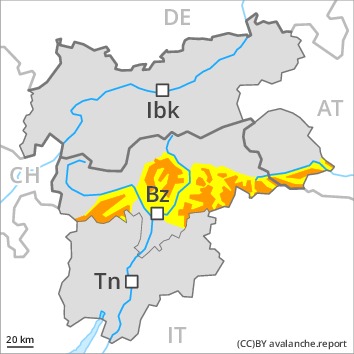
Danger level
 | 1600m
|
Avalanche Problem
 | | Persistent weak layer |
|  | |  |
 | | Wind-drifted snow |
|  | |  |

A precarious avalanche situation will be encountered over a wide area.
The danger exists in particular in alpine snow sports terrain. Caution and restraint are important.
As a consequence of new snow and a strong to storm force northwesterly wind, further wind slabs will form. Avalanches can in many places be released, even by a single winter sport participant. The number and size of avalanche prone locations will increase with altitude.
Additionally avalanches can also penetrate deep layers and reach quite a large size, this also applies in areas close to the tree line, as well as below the tree line. Remotely triggered avalanches are possible. The avalanche prone locations are difficult to recognise.
Snowpack
dp.6: cold, loose snow and wind
dp.5: snowfall after a long period of cold
10 to 30 cm of snow, and even more in some localities, will fall until the early morning. The sometimes storm force wind will transport the fresh and old snow. As a consequence of low temperatures the snowpack can not consolidate. The old snowpack is faceted and its surface consists of surface hoar. Whumpfing sounds and the formation of shooting cracks when stepping on the snowpack and stability tests confirm the unfavourable bonding of the snowpack.
Tendency
A precarious avalanche situation will be encountered over a wide area.

Danger level
 | 1600m
|
Avalanche Problem
 | | Persistent weak layer |
|  | |  |
 | | Wind-drifted snow |
|  | |  |

A critical avalanche situation will be encountered over a wide area.
The danger exists in particular in alpine snow sports terrain. Great caution and restraint are important.
As a consequence of new snow and a sometimes strong northwesterly wind, further wind slabs will form. Avalanches can in many places be released very easily. These can penetrate deep layers and reach large size. Remotely triggered avalanches are possible, this also applies in areas close to the tree line, as well as below the tree line. The avalanche prone locations are difficult to recognise.
Snowpack
dp.6: cold, loose snow and wind
dp.5: snowfall after a long period of cold
20 to 40 cm of snow, and even more in some localities, will fall until the early morning. The old snowpack is faceted and its surface consists of surface hoar. The northwesterly wind will transport the new snow. The brittle wind slabs are lying on the unfavourable surface of an old snowpack. As a consequence of low temperatures the snowpack can settle hardly at all. Whumpfing sounds and the formation of shooting cracks when stepping on the snowpack and stability tests confirm the existence of a weak snowack.
Tendency
A critical avalanche situation will be encountered over a wide area.

Danger level
 | treeline
|
Avalanche Problem
 | | Wind-drifted snow |
|  | |  |
 | | Persistent weak layer |
|  | |  |

Wind slabs and weakly bonded old snow are to be critically assessed.
The fresh and somewhat older wind slabs can in some cases be released easily. As a consequence of the sometimes strong wind the wind slabs will increase in size additionally as the day progresses.
In particular on steep east, south and west facing slopes avalanches can be triggered in the faceted old snow and reach large size in some cases. This applies in particular above the tree line.
Snowpack
dp.5: snowfall after a long period of cold
dp.8: surface hoar blanketed with snow
The sometimes storm force wind has transported the loosely bonded old snow. The brittle wind slabs are lying on unfavourable layers on steep east, south and west facing slopes. Various wind slab layers are lying on soft layers. Towards its base, the snowpack is well consolidated.
Tendency
Wind slabs require caution.

Danger level
 | treeline
|
Avalanche Problem
 | | Wind-drifted snow |
|  | |  |
 | | Persistent weak layer |
|  | |  |

A dangerous avalanche situation will prevail. New snow and wind slabs represent the main danger.
The new snow and wind slabs are lying on the unfavourable surface of an old snowpack in all aspects above approximately 1600 m. Slopes close to the tree line where surface hoar has been covered with snow are especially precarious. Avalanches can be triggered in the faceted old snow and reach large size in isolated cases. Natural avalanches are possible in particular on wind-loaded slopes.
As a consequence of the sometimes strong wind the wind slabs will increase in size additionally. In addition a latent danger of gliding avalanches exists.
Backcountry touring calls for great caution and restraint.
Snowpack
dp.5: snowfall after a long period of cold
dp.8: surface hoar blanketed with snow
The sometimes strong wind has transported the new snow and, in some cases, old snow as well. The brittle wind slabs are lying on unfavourable layers in all aspects. Over a wide area various wind slab layers are lying on surface hoar.
Precarious weak layers exist in the centre of the snowpack.
Tendency
The avalanche conditions are to some extent precarious. New snow and wind slabs are to be assessed with care and prudence.

Danger level
 | 1800m
|
Avalanche Problem
 | | Wind-drifted snow |
|  | |  |
 | | Persistent weak layer |
|  | |  |

A critical avalanche situation will prevail.
The new snow and wind slabs can be released easily, or, in isolated cases naturally in all aspects. In the event of solar radiation this applies in particular on wind-loaded slopes as well as. Avalanches can penetrate deep layers and reach large size. Caution is to be exercised also below the tree line. The avalanche prone locations are sometimes covered with new snow and are difficult to recognise. Remotely triggered avalanches are possible. In the north the avalanche prone locations are more prevalent and the danger is greater. Gliding avalanches can also occur.
Caution and restraint are important.
Snowpack
dp.5: snowfall after a long period of cold
dp.6: cold, loose snow and wind
In the north in some localities up to 10 cm of snow will fall on Monday. The old snowpack is faceted; its surface is loosely bonded and consists of surface hoar and faceted crystals. The sometimes strong wind will transport the new snow and, in some cases, old snow as well. The brittle wind slabs are lying on the unfavourable surface of an old snowpack. Whumpfing sounds and the formation of shooting cracks when stepping on the snowpack and field observations confirm poor snowpack stability.
Tendency
A critical avalanche situation will prevail. Caution and restraint are important.

Danger level
 | treeline
|
Avalanche Problem
 | | Wind-drifted snow |
|  | |  |
 | | Wind-drifted snow |
|  | |  |

Fresh wind slabs require caution.
The new snow and wind slabs are lying on the unfavourable surface of an old snowpack in particular on steep shady slopes, also in areas close to the tree line, as well as below the tree line. Avalanches can be triggered in the faceted old snow and reach medium size in some cases. Avalanches can additionally be released on cut slopes.
Snowpack
dp.6: cold, loose snow and wind
dp.5: snowfall after a long period of cold
As a consequence of the northwesterly wind the wind slabs will increase in size additionally. In some places new snow and wind slabs are lying on a weakly bonded old snowpack, in particular on shady slopes. As a consequence of low temperatures the snowpack can settle hardly at all.
Tendency
Slight decrease in avalanche danger as a consequence of warming.

Danger level
 | treeline
|
Avalanche Problem
 | | Wind-drifted snow |
|  | |  |
 | | Persistent weak layer |
|  | |  |

A sometimes critical avalanche situation will prevail.
The fresh and somewhat older wind slabs can be released easily in all aspects. This applies above the tree line, as well as in areas close to the tree line. Mostly avalanches are medium-sized. As a consequence of solar radiation individual natural avalanches are possible as the day progresses. Remotely triggered avalanches are possible in isolated cases.
Caution and restraint are important.
Snowpack
dp.6: cold, loose snow and wind
dp.8: surface hoar blanketed with snow
The strong wind has transported the fresh and old snow significantly. The old snowpack consists of faceted crystals; its surface is loosely bonded and consists of surface hoar and faceted crystals. The brittle wind slabs are lying on unfavourable layers.
Isolated avalanche prone weak layers exist in the top section of the snowpack. Whumpfing sounds and the formation of shooting cracks when stepping on the snowpack have confirmed poor snowpack stability.
Tendency
A critical avalanche situation will be encountered in some regions. Caution and restraint are recommended.

Danger level
 | 1600m
|
Avalanche Problem
 | | Wind-drifted snow |
|  | |  |
 | | Persistent weak layer |
|  | |  |

Considerable, level 3. The fresh and older wind slabs represent the main danger.
The new snow and wind slabs are prone to triggering in all aspects above approximately 1600 m. Avalanches can in many places be released easily and reach medium size.
Avalanches can additionally be released in deeper layers also. Remotely triggered avalanches are possible. Especially places where surface hoar has been covered with snow are treacherous. Whumpfing sounds and the formation of shooting cracks when stepping on the snowpack serve as an alarm indicating the danger.
In addition an appreciable danger of gliding avalanches exists.
Backcountry touring calls for experience in the assessment of avalanche danger. Meticulous route selection is important.
Snowpack
dp.6: cold, loose snow and wind
dp.8: surface hoar blanketed with snow
The strong wind has transported some snow. The brittle wind slabs are poorly bonded with the old snowpack.
Precarious weak layers exist in the top section of the snowpack. As a consequence of low temperatures the snowpack can not consolidate.
Tendency
Hardly any decrease in avalanche danger.





















